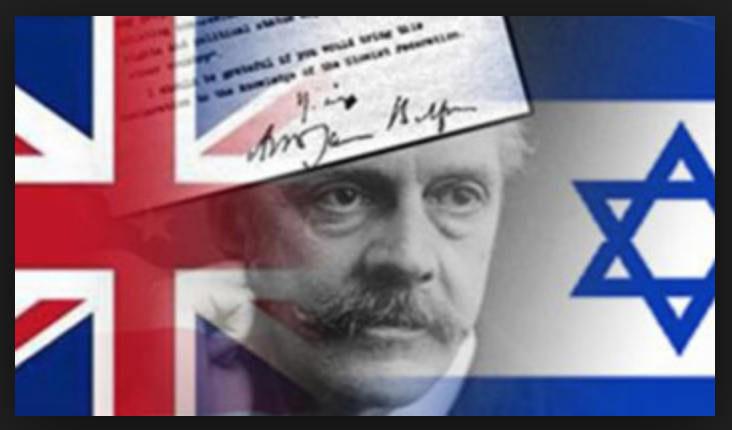
This week, Palestinians around the world are marking 100 years since the Balfour Declaration was issued on November 2, 1917.
The declaration turned the Zionist aim of establishing a Jewish state in Palestine into a reality when Britain publicly pledged to establish “a national home for the Jewish people” there.
The pledge is generally viewed as one of the main catalysts of the Nakba – the ethnic cleansing of Palestine in 1948 – and the conflict that ensued with the Zionist state of Israel.
It is regarded as one of the most controversial and contested documents in the modern history of the Arab world and has puzzled historians for decades.
What is the Balfour Declaration?
The Balfour Declaration (“Balfour’s promise” in Arabic) was a public pledge by Britain in 1917 declaring its aim to establish “a national home for the Jewish people” in Palestine.
The statement came in the form of a letter from Britain’s then-foreign secretary, Arthur Balfour, addressed to Lionel Walter Rothschild, a figurehead of the British Jewish community.
It was made during World War I (1914-1918) and was included in the terms of the British Mandate for Palestine after the dissolution of the Ottoman Empire.
The so-called mandate system, set up by the Allied powers, was a thinly veiled form of colonialism and occupation.
“Greater Israel”: The Zionist Plan for the Middle East
The system transferred rule from the territories that were previously controlled by the powers defeated in the war – Germany, Austria-Hungary, the Ottoman Empire and Bulgaria – to the victors.
The declared aim of the mandate system was to allow the winners of the war to administer the newly emerging states until they could become independent.
The case of Palestine, however, was unique. Unlike the rest of the post-war mandates, the main goal of the British Mandate there was to create the conditions for the establishment of a Jewish “national home” – where Jews constituted less than 10 percent of the population at the time.
Upon the start of the mandate, the British began to facilitate the immigration of European Jews to Palestine. Between 1922 and 1935, the Jewish population rose from nine percent to nearly 27 percent of the total population.
What the map of #Palestine looked like 100 years ago
A post shared by AJ Labs (@aj_labs) on Oct 28, 2017 at 9:50pm PDT
Though the Balfour Declaration included the caveat that “nothing shall be done which may prejudice the civil and religious rights of existing non-Jewish communities in Palestine”, the British mandate was set up in a way to equip Jews with the tools to establish self-rule, at the expense of the Palestinian Arabs.
Why was it controversial?
The document was controversial for several reasons.
Firstly, it was, in the words of the late Palestinian-American academic Edward Said, “made by a European power … about a non-European territory … in a flat disregard of both the presence and wishes of the native majority resident in that territory”.
In essence, the Balfour Declaration promised Jews a land where the natives made up more than 90 percent of the population.
Secondly, the declaration was one of three conflicting wartime promises made by the British.
When it was released, Britain had already promised the Arabs independence from the Ottoman Empire in the 1915 Hussein-McMahon correspondence.
The British also promised the French, in a separate treaty known as 1916 Sykes-Picot agreement, that the majority of Palestine would be under international administration, while the rest of the region would be split between the two colonial powers after the war.
The declaration, however, meant that Palestine would come under British occupation and that the Palestinian Arabs who lived there would not gain independence.
Finally, the declaration introduced a notion that was reportedly unprecedented in international law – that of a “national home”.
The use of the vague term “national home” for the Jewish people, as opposed to “state”, left the meaning open to interpretation.
Earlier drafts of the document used the phrase “the reconstitution of Palestine as a Jewish State”, but that was later changed.
In a meeting with Zionist leader Chaim Weizmann in 1922, however, Arthur Balfour and then-Prime Minister David Lloyd George reportedly said the Balfour Declaration “always meant an eventual Jewish state”.
The question of why the Balfour Declaration was issued has been a subject of debate for decades, with historians using different sources to suggest various explanations.
While some argue that many in the British government at the time were Zionists themselves, others say the declaration was issued out of an anti-Semitic reasoning, that giving Palestine to the Jews would be a solution to the “Jewish problem”.
In mainstream academia, however, there are a set of reasons over which there is a general consensus:
- Control over Palestine was a strategic imperial interest to keep Egypt and the Suez Canal within Britain’s sphere of influence
- Britain had to side with the Zionists to rally support among Jews in the United States and Russia, hoping they could encourage their governments to stay in the war until victory
- Intense Zionist lobbying and strong connections between the Zionist community in Britain and the British government; some of the officials in the government were Zionists themselves
- Jews were being persecuted in Europe and the British government was sympathetic to their suffering
Source Article from http://feedproxy.google.com/~r/ASheepNoMore/~3/4KQFxGmGgU4/
Related posts:
Views: 0
 RSS Feed
RSS Feed

















 November 4th, 2017
November 4th, 2017  Awake Goy
Awake Goy  Posted in
Posted in  Tags:
Tags: 
















